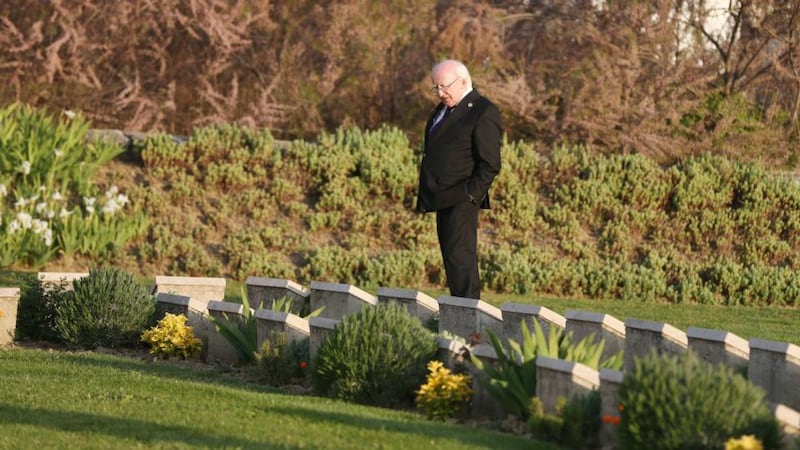There are white carnations on the graves of the erstwhile forgotten Irish of V Beach this morning.
They were put there by a president and by his wife, and by two princes of the army in which they fought and died.
One is on the memorial grave stone tablet of Robert Ludlow, formerly of Magdaline Terrace in Galway.

There's one for Capt Walford VC and one for Petty Officer William Medhurst, a young sailor who rowed the Dublins and Munsters on to the beach at Sedd-ul-Bahr, where they were mown down.
As the bullets peppered his boat and the Irish men died or fell into the sea wounded, Medhurst dived in to help, sustaining fatal wounds in the process.
Britain’s Prince Charles singled out Walford and Medhurst for special floral attention.
V Beach cemetery contains the bodies of some 700 soldiers who landed at Cape Helles in late April 1915. Only about 200 have been identified, and most of them were in the Royal Dublin and Royal Munster fusiliers.
Above them now on the clifftop sits the huge obelisk that is the Helles Memorial, inscribed with the names of some 21,000 British, Irish, Canadian, Australian, New Zealand, Indian, Pakistan and Sri Lankan soldiers who died in the disastrous Gallipoli campaign and who have no known grave.
Twenty-five thousand other Commonwealth soldiers are interred in cemeteries that dot the peninsula.
The sun was setting after yesterday's 100th anniversary memorial service – entitled officially the Commonwealth and Ireland service – when Prince Charles and his son Prince Harry went down to the beach, followed by President Michael D Higgins and his wife, Sabina.
As the sun nudged the clifftop and the light grew golden, they strolled along the rows of ankle-high memorial tablets, so many of which state simply, Their glory shall not be blotted out – which is, more or less, exactly what happened, glory or not.
Commonwealth War Graves Commission historian Glyn Prysor explained for the princes and the Higginses some of the details of what happened at V Beach - the press remaining at the sort of distance expected on such occasions.
But as their wandering through the graves continued, the formalities began to loosen. A large bunch of white carnations was produced and split between the four for placing at will. They were scattered liberally.
Danagher tablet
At the top of the cemetery, Sabina called her husband to come quickly. She was standing at the tablet for Company Sgt-Maj D Danagher of the Munsters who died, aged 37, on April 25th, the first day of the landings. His grandson became the first Labour mayor of Limerick, a fact known to the president.
“Isn’t is great that we found him?” said Sabina to her husband as they placed three flowers on his memorial stone.
And then she strolled to the cemetery's altar – their name liveth forever – and left the remainder of her flowers there for the others. Walking back towards Prince Charles she said: "May they all rest in peace."
The dead of Gallipoli were remembered at three separate ceremonies on the eve of Anzac Day, April 25th, when Australia and New Zealand remember their dead from a campaign that forged in those countries a sense of identity that has endured.
The first ceremony was, appropriately, at the Turkish memorial, the giant Mehmetcik monument to the estimated 100,000 Turks who died and perhaps double that number who were wounded.
As the Turkish memorial ceremony came to a close, a Turkish frigate, sailing at a stately pace, led a sail-past of Cape Helles, the Turkish vessel followed by an Allied one, and by a Turkish one again, and then another Allied one, until 11 ships passed, the largest of them being HMS Bulwark, an amphibious assault ship.
A scream of seven Turkish Air Force RF5 jets tore through the sky. And they did it again and again and again, as if to make a point. Four Turkish military officers, dressed in period uniforms of 1915, rode horses in the field in front of the Helles Memorial.
The ceremony was a textbook example of one of the things the British do well: a degree of pomp, lots of circumstance and everything running smoothly (if a little late).
When Turkish president Recep Tayyip Erdogan, the two princes and President and Mrs Higgins arrived, a 54-strong guard of honour, drawn from sailors from HMS Bulwark, snapped to attention.
Irish participation was marked by an unprecedented level of involvement by the Defence Forces. The President was accompanied by Minister for Foreign Affairs Charlie Flanagan and Chief of Staff, Lieut-Gen Conor O'Boyle.
Six members of the Defence Forces also participated – Company Sgt Jim Aherne, 7 Infantry Battalion; Naval Service Petty Officer Cormac de Barra; Piper Sgt Joe Meade, 7 Infantry Battalion; Naval Service Petty Officer Kevin Meade; Sgt Tracy Walsh of the Air Corps; and Airman Michael Whelan.
The President's green laurel wreath, standing out among the other 14 poppy wreaths, had the inscription: On behalf of the people of Ireland.
The Chaplain General to the British Land Forces said they were gathered to recall the courage of those who had died and to pray for the countries represented.
Company Sgt Ahern gave a reading. It was from a letter written by Royal Dublin Fusilier Capt Paddy Tobin to his father, three days before he was killed on August 13th, 1915.
In it, Capt Tobin described trying to cross a sand spit at Suvla Bay. Shrapnel and high explosives were bursting as frequently as the tick of a clock, he wrote.
They never found Billy Tobin, but his name is on the Helles Memorial and he was remembered yesterday.













